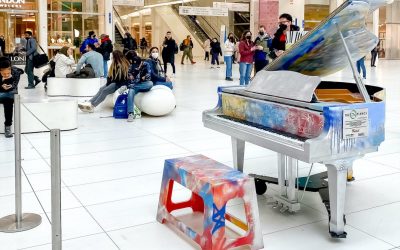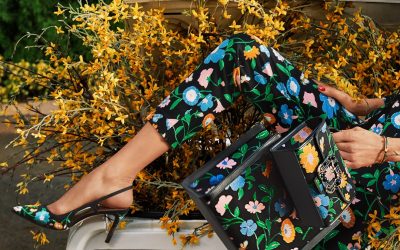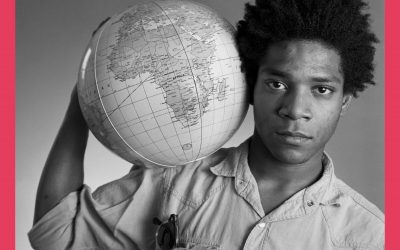
The Style of Movement: Fashion and Dance, by photographers Ken Browar and Deborah Ory, founders of NYC Dance Project, explores the intertwined artistry and grace that links fashion, dance, and the art of photography. A follow-up to Ory and Browar’s first book, The Art of Movement, this new iteration offers an even more fascinating look at the talent, imagination, and sense of flow the husband-and-wife duo capture with a click of the lens. A well-known fashion and beauty photographer, Browar’s interest and love for dance began while photographing dancers for the Paris Opera Ballet.
Ory began her career as a dancer, only to find an affinity for photography while photographing rehearsals during a period in which she was injured. In that sense, happenstance pushed Ory down a path that led her to work as a photo editor for magazines such as Mirabella and House & Garden and shooting editorial for a breadth of other publications.
Today, Ory and Browar’s work has been featured in some of the most compelling magazines and galleries around the world. In testimony towards their gift for inspiring beauty and grace through fashion, dance and photography, fabled Italian fashion designer Valentino, and Pamela Golbin, the former curator of the fashion and textile collection at Musée Les Arts Décoratifs in Paris, offer dazzling praise in their respective foreword and introduction to The Style of Movement: Fashion and Dance. Below, Ory and Browar allowed us some time on their dance card and answered some of our most pressing questions.
Downtown: When did the idea of collaborating occur?

Ory: I met Ken many years ago when we were both already working as photographers. We had been working for many years as solo artists, but we liked the idea of working together. When we both decided to stop doing commercial work and focus on a personal project, we thought it would be nice to collaborate on a passion project
Downtown: Can you tell us our readers about when you founded NYC Dance Project, its mission, and how it ties into your books?
Deborah Ory: I had grown up dancing and was a dance major in college. My children had started dancing at the American Ballet Theatre school and my daughter was doing “The Nutcracker” when she was 12.
We wanted to surprise her and put photographs of her favorite dancers with the American Ballet Theatre on the walls in her bedroom. We found there were not many photographs of the dancers she loved other than performance photos. We contacted one of her favorite dancers from the company, Daniil Simkin, on social media and asked him if he would like to work with us. At our first photo session with Daniil he suggested photographing some other dancers in the company. After a few sessions, it quickly developed into a project and we expanded it to include other dance companies. It felt like a natural development to make this work a book, and several years later, our first book, The Art of Movement, was published.
DT: How long did it take to put together your second book, The Style of Movement: Fashion and Dance?
DO: Each book took us about three years to make. The books are each 300 pages, so it was a lot to get done that quickly!
DT: Deborah, how much does your background in dance influence the shoots, the models, the clothes? How does Ken’s background photographing fashion influence all of the above in a different manner?

DO: I had both a background in dance, photography, and fashion, so this book was a perfect combination of my passions. I studied the Martha Graham technique when I was dancing, and I think there is a definite tribute to the Martha Graham Dance Company in the book—we had their Artistic Director, Janet Eilber, write about Graham’s influence on fashion. Ken has worked a lot with fashion models, but has really enjoyed photographing dancers. He also has a strong background in lighting and studio work, which was very helpful.
DT: What is it you most loved about putting the book together? About the result?
DO: It’s always satisfying to work on a long-term project when you see it coming together. In the beginning, it was just an idea and a few photographs. It’s exciting when it started to feel like a book and when we got to see the images all playing well together in layout format. It’s even better to see the final product. It’s so much work to create a book of this size, that it’s really wonderful to see it come together after working on it for so long.
DT: What is most special to you both about having a foreword by Valentino in your new book?
DO: It was an honor to have Valentino write our foreword. He also picked out two dresses for us when photographing Tiler Peck, who he has stated is one of his favorite dancers. These were vintage pieces that he had sent from Paris. We used one on Tiler for our cover and the other dress was used next to his foreword.

DT: We found the process of gathering fashion designs fascinating. Is there a particularly memorable experience tracking down a particular designer’s work for the photoshoots, and likewise, a particularly memorable experience from a designer that tracked you down?
DO: One of the designers we reached out to was the Creative Director of a very well known brand. I tried to get in touch with someone at the company for almost a year, with no luck. Eventually I reached out on Instagram and the Creative Director sent me his personal phone number. Within a week, we had a rack of clothing from the company delivered to our studio! It was very surprising to me that you could actually reach someone that well-known through Instagram.
DT: How many outfits does each dancer typically wear per shoot? How do you narrow down the final images/outfits?
DO: Some of the dancers wore many different outfits and others just wore 1–2. It depended a lot on how the clothing was working, how many pieces we had at the studio that day, and how long we had the dancer for! Sometimes one outfit just worked perfectly and that’s all we needed.

DT: There is a line by fashion designer Belinda Pieris that says: “When a child puts on a dress often the first thing she does is spin to feel how it moves with each other.” We thought that a very poignant take on how fashion and design go hand-in-hand. How do you think they go together and what about the art of photography plays into this idea?
DO: I loved this quote also, I think she is exactly right that it’s very instinctual to move in certain types of garments. Photography is just the tool we use to capture that feeling and idea.
DT: There are some dancers whose shoots blew us away… all of them did, but some of them are pure magic. We had that feeling when we saw the photographs of Michael Trusnovec in the classic black tuxedo with vintage tails. Can you tell our readers a bit about this particular shoot?
DO: We had photographed Michael Trusnovec before and he had talked to us previously about being inspired by Fred Astaire. Michael is a very elegant dancer and we loved the idea of putting him in tails. We knew we wanted that classic, iconic look somewhere in our book and he was the perfect dancer for this. We gave him a vintage cane to add to the drama of the image, and we were astonished when he balanced in mid-air leaning against it. I’m not exactly sure how he did that!
DT: The work of Iris Van Herpen appears to be made for a dancer! How did you end up working with her for the book?
DO: I had my eye on Iris Van Herpen’s work from the moment we conceived of the book idea. Her work is so sculptural and dramatic and she had designed for the New York City Ballet before we worked with her. She had been a dancer growing up, so she was happy to participate.

DT: Are there any designers you have not yet worked with that you would love to try to work with?
DO: I’m very fascinated with Alexander McQueen and would have liked to include some of his vintage pieces in the book. There were a few pieces in particular that I spent a lot of time trying to track down. However, most of these were one-of-a-kind pieces made for the runway and most are in museum collections, so it was not possible for us to get them. I think they would have made for some amazing photos on dancers!
We did an homage to him. He once created a dress of flowers, where during the runway show, the flowers were dying and falling off the model. We made our own version, with the help of a costume designer, a florist, and a flower company which gave us hundreds of flowers to work with. It was an incredible experience, although I was not sure we could actually pull it off until it finally was put together. Even with weeks of planning, it took all of us several hours to make this dress. It was made on the dancer.

DT: Can we expect another book? While we wait with bated breath, where can our readers purchase this particular book?
DO: The book is available in bookstores everywhere and also online at Barnes & Noble, Amazon, and other booksellers. We do have some ideas for another book. We’re trying to refine our ideas and figure out what’s possible. And we are taking a much needed rest before we begin any further projects!
See More
Chefs Sarit Packer and Itamar Srulovich of Honey & Co. Release a Mouthwatering New Cookbook
Q&A with Multitalented Designer, Emma O’Donnell
Interior Designer Alan Tanksley Reinvisions Luxury, Project by Project
“The Art of The Host” by Alex Hitz is a Guide to Flawless Entertaining













